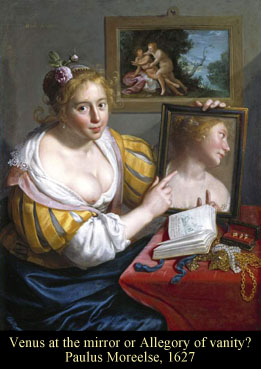Venus at the mirror or Allegory of vanity?
Paulus Moreelse, 1627
Northern European Baroque
The Fitzwilliam Museum, Cambridge, UK
From the Middle Ages onwards many artists, not only famous ones like Giorgione, Veronese, Titian, Rubens, Goya, Ingres or Manet,
increasingly turned their attention to images of Venus. In their approach of this great mythological subject, they also sharpen their
skills in the portrayal of the seductive beauty as well as the sexual attractiveness of the female body.
Women could personify positive concepts such as Veritas (Truth), Sapientia (Wisdom), Prudentia (Prudence), but also negative ones
such as Superbia (Arrogance), Vanitas (Vanity) or Lascivia (Wantonness). Few paintings, however, possess the great complexity as
presented here in ”Woman at the mirror” by Paulus Moreelse (1627) that has intrigued, challenged and divided scholars ever since.
There are many aspects and possible interpretations of this not very well known work. Does this painting represent Venus at the mirror,
is it an allegory of vanity or simply an allegory of profane love? The answer to this question is not easy because concepts of sensuality,
vanity, and material wealth are masterfully combined in the painting.
The painting represents a young, attractive woman, who looks at the viewer with a seductive smile and points to her reflection in a mirror.
Her physical appearance is so important to the narration of the painting that the painter decided to show us two views of her face.
Her mirror image, however, reflects only the vaguest suggestion of her face in profile. The neckline of her loosened white shirt is so low that
it exposes one of her nipples, inviting us to enjoy her youth and beauty. The velvet of the table cloth, the blue and yellow satin of her dress,
the white cotton of her blouse conveys a rich, sensual feeling.
On the table before her stands the mirror several pieces of shimmering jewelry, gold chains, a string of pearls and a small book.
The small book is opened on a page that shows a kneeling woman offering a gift to Venus and Amor.
The text below the illustration can be translated as follows:
”The desire of the flesh (lascivia) does not live for itself but for Venus. To her she offers gold and jewels and all riches.”
The pinkish red roses in the woman's hair, a flower that is indeed the traditional attribute of Venus, suggest that she is a personification of the deity.
But are the roses here truly meant as an attribute of the goddess of love?
The presence of gold and jewels on the table before her would suggest that, rather than Venus, the woman symbolizes the pleasure
of having precious possessions. This idea of Voluptuousness as one of the central concepts of this painting is confirmed by the scene in the b
ackground. The background painting on the back wall above the woman's head shows an erotic scene of two nude figures in a landscape.
It is taken from Ovid's ”Metamorphoses” and features the blond, naked nymph Salmacis trying to embrace the objecting
Hermaphroditus. A rare physical beauty, Hermaphroditus was the son of the god Hermes and the goddess Aphrodite. On seeing him,
the nymph Salmacis falls instantly in love and longs to possess him. Salmacis symbolizes here the sensual seductress who eventually
succeeds in obtaining her priced possession. In this sense she is a perfect match for the young woman with the mirror, and quite possibly
Moreelse chose it for that reason.
The mirror plays a critical role in the painting. By itself it is a symbol of vanity, but here we see an incorrectly reflected image
of the woman, suggesting that it symbolizes the deceptive nature of external beauty. This explanation fits with the one provided
by Moreelse contemporary Van Mander (the Dutch Vasari) in his book ”Commentary of Figures” from 1604. According
to Van Mander the mirror is a symbol for falsehood in the sense of deception,
because it only reflects the appearance, but not the internal truth.
The northern European painters of this period were looking for a new, more secular pictoral language, that by its moralizing
character simultaneously entertain and educate its spectators.
In this picture, painted with love and affection, Moreelse wanted to make clear in a skillfully playful manner and an inoffensively
moralizing tone that the tempting quality of the young woman is based only on her attractiveness, seductiveness and voluptuousness.
The external beauty is by definition merely appearance. The combination of sensuality, vanity and material wealth, exact description
of profane love, can be very dangerous.
Whether Moreelse really meant that his painting should be interpreted in this way is difficult to determine. But certainly
it was intended as a warning against other dangers of voluptuousness and material wealth that offer uncontrolled romance,
lovemaking and evil of immorality.
In a strict society of 17th century Utrecht this attractive, flirtatious young woman would have surely been open to
public disapproval and condemnation. Aernt van Buchel, close friend of Moreelse, in his poem ”On the
painting of lascivious Vanitas made by P. Moreelse” wrote the words:
”This is the image of the vain World, and the triumph of the flesh
Where the greedy, rapacious demon always holds sway,
Riches is busy with Venus, evil furor with love;
Both are in a blind rage, both do not know measure.
Let these be the antidote and cure for immoral sorrow:
Fasting, tears, or better: contrition over evil.”
which interpretation seems to confirm our hypothesis.
